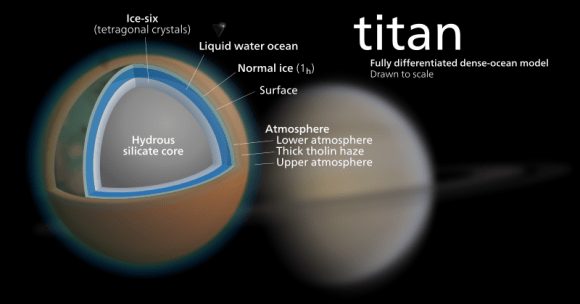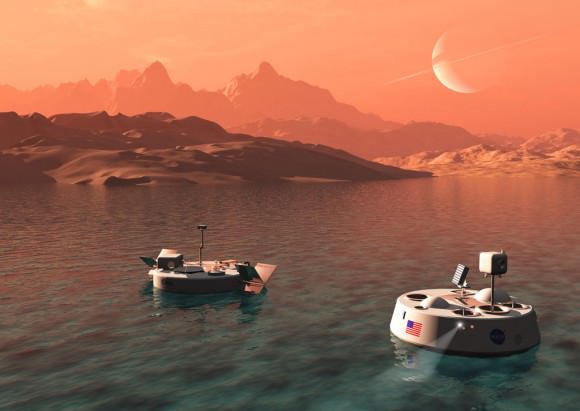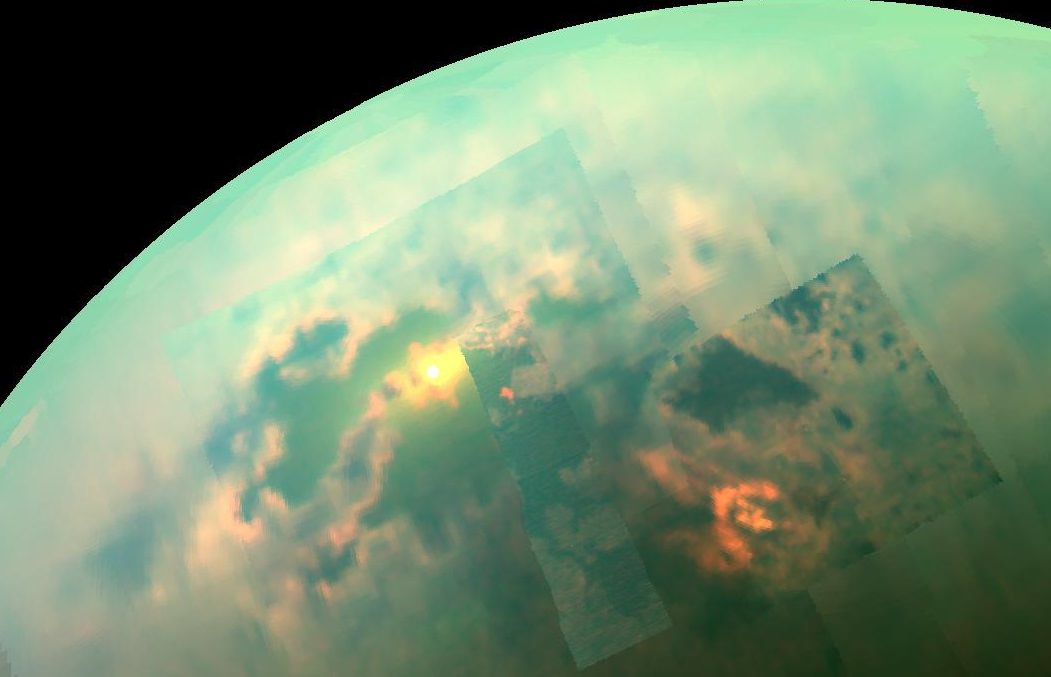Saturn’s largest moon Titan is a truly fascinating place. Aside from Earth, it is the only place in the Solar System where rainfall occurs and there are active exchanges between liquids on the surface and fog in the atmosphere – albeit with methane instead of water. It’s atmospheric pressure is also comparable to Earth’s, and it is the only other body in the Solar System that has a dense atmosphere that is nitrogen-rich.
For some time, astronomers and planetary scientists have speculated that Titan might also have the prebiotic conditions necessary for life. Others, meanwhile, have argued that the absence of water on the surface rules out the possibility of life existing there. But according to a recent study produced by a research team from Cornell University, the conditions on Titan’s surface might support the formation of life without the need for water.
When it comes to searching for life beyond Earth, scientists focus on targets that possess the necessary ingredients for life as we know it – i.e. heat, a viable atmosphere, and water. This is essentially the “low-hanging fruit” approach, where we search for conditions resembling those here on Earth. Titan – which is very cold, quite distant from our Sun, and has a thick, hazy atmosphere – does not seem like a viable candidate, given these criteria.

However, according to the Cornell research team – which is led by Dr. Martin Rahm – Titan presents an opportunity to see how life could emerge under different conditions, one which are much colder than Earth and don’t involve water.
Their study – titled “Polymorphism and electronic structure of polyimine and its potential significance for prebiotic chemistry on Titan” – appeared recently in the Proceedings of the National Academy of Sciences (PNAS). In it, Rahm and his colleagues examined the role that hydrogen cyanide, which is believed to be central to the origin of life question, may play in Titan’s atmosphere.
Previous experiments have shown that hydrogen cyanide (HCN) molecules can link together to form polyimine, a polymer that can serve as a precursor to amino acids and nucleic acids (the basis for protein cells and DNA). Previous surveys have also shown that hydrogen cyanide is the most abundant hydrogen-containing molecule in Titan’s atmosphere.
As Professor Lunine – the David C. Duncan Professor in the Physical Sciences and Director of the Cornell Center for Astrophysics and Planetary Science and co-author of the study – told Universe Today via email: “Organic molecules, liquid lakes and seas (but of methane, not water) and some amount of solar energy reaches the surface. So this suggests the possibility of an environment that might host an exotic form of life.”

Using quantum mechanical calculations, the Cornell team showed that polyimine has electronic and structural properties that could facilitate prebiotic chemistry under very cold conditions. These involve the ability to absorb a wide spectrum of light, which is predicted to occur in a window of relative transparency in Titan’s atmosphere.
Another is the fact that polyimine has a flexible backbone, and can therefore take on many different structures (aka. polymorphs). These range from flat sheets to complex coiled structures, which are relatively close in energy. Some of these structures, according to the team, could work to accelerate prebiotic chemical reactions, or even form structures that could act as hosts for them.
“Polyimine can form sheets,” said Lunine, “which like clays might serve as a catalytic surface for prebiotic reactions. We also find the polyimine absorbs sunlight where Titan’s atmosphere is quite transparent, which might help to energize reactions.”
In short, the presence of polyimine could mean that Titan’s surface gets the energy its needs to drive photochemical reactions necessary for the creation of organic life, and that it could even assist in the development of that life. But of course, no evidence has been found that polyimine has been produced on the surface of Titan, which means that these research findings are still academic at this point.

However, Lunine and his team indicate that hydrogen cyanide may very well have lead to the creation of polyimine on Titan, and that it might have simply escaped detection because of Titan’s murky atmosphere. They also added that future missions to Titan might be able to look for signs of the polymer, as part of ongoing research into the possibility of exotic life emerging in other parts of the Solar System.
“We would need an advanced payload on the surface to sample and search for polyimines,” answered Lunine, “or possibly by a next generation spectrometer from orbit. Both of these are “beyond Cassini”, that is, the next generation of missions.”
Perhaps when Juno is finished surveying Jupiter’s atmosphere in two years time, NASA might consider retasking it for a flyby of Titan? After all, Juno was specifically designed to peer beneath a veil of thick clouds. They don’t come much thicker than on Titan!
Further Reading: PNAS


It was my impression that Juno will be out of fuel by it’s mission end. I’ve heard a few people imply that it might be repurposed after the mission is complete, but isn’t this impossible? Particularly a repurposing that involves so much dV as moving on to Saturn and achieving an orbit around Titan?
Their plan is to crash it in the surface of Jupiter when they use all they can from the craft, just as they did Galileo.
Definitely not enough fuel left in it to get to Saturn.
Going from Jupiter to Saturn is as hard as launching from Earth to Jupiter. Juno did not exactly bring another Atlas V along. It is a pretty specialized set of instruments, I do not see how it could be repurposed for anything.
plus a launch window from Jupiter to Saturn only happens every 17 or 18 terran years
Yeah, that too. The Jupiter/Saturn alignments were historically important in astrology. I heard that it could even be the motivation for why the Babylonians used 12 and 60 as their base for math. Because they conjunct at the same place in the sky every 960 years. People figured that out thousands of years ago. Astronomy isn’t as popular as it used to be. I suppose quantum cosmology is harder to accept than astrology was.
I would think that life on/in Titan comes from its subsurface water ocean. As it leaks out to the surface it might adapt and evolve in the hostile frozen methane world out there. But really thrive deep inside.
Isn’t funny how the simplest combinations of the most common elements try to kill us? H, O and C in their simplest combinations. H2 and O2 is an explosive combination. CO is poisonous. HCN, mentioned here, is one of the most lethal substances imaginable. And every cell in our bodies recombine those simple elements to molecules all the time. Trillions of times per second, and it works. It bends my mind trying to grasp it.
I’m pretty sure rainfall happens in other places, E.G. Venus has sulfuric acid rain. I think its believed it is vaporized before it reaches the surface so maybe that doesn’t count.
I’m not sure the water is the necessary component. Life we see on Earth needs energy, which ultimately lead to reproduction. Nature has come up with some creative ways in our own backyard to achieve this. Look at how different you are from the tree out front. That thing pulls water and nutrients out of the dirt and conducts photosynthesis. We feed on other life, use the sun for vitamin D purposes, and have wake/sleep cycles. Water seems necessary here, but maybe its just liquid that is necessary. Or a place like the shore where solid liquid and gas all kinda meet up.
I think astrobiology will push the very limits of what is defined as “life” and “organic” Even here on Earth we don’t consider viruses to be life. I’d bet nature has produced lots of single celled freely moving…things. Other amino and nucleic acids may group in various ways and form non DNA based multi cellular life. Possibilities are endless!
“… where rainfall occurs *and there are active exchanges* between liquids on the surface and fog in the atmosphere”
I always loved the late great Carl Sagans vision of hypothetical winged angelic beings composed of gas plasmas in Jupiters cloud tops. We have only just begun exploring such extreme environments with our earthly robots.. It helps to keep an open mind and imagination and not rule things out until we have done the exploration thouroughly..
Water is bipolar and a great solvent. It seems like water molecules covering macro molecules is an important part of biology. Other bipolar molecules might do the job, but not methane. And water is one of the most common molecules in the universe. So I think water is necessary for life.
“… Titan’s surface gets the energy its needs to drive photochemical reactions necessary for the creation of organic life…”
LIFE HAS BEEN DISCOVERED ON TITAN !!! :silly:
Certainly in our imaginations.. Now we just need to send some robots to get the happy snaps to complete the titan family tree 😉
It makes a lot of sense to go where our type of life would not thrive, and look for something quite different. If the planet was a static chunk of ice, nothing would ever evolve. If it was a ball of fire, nothing would survive. If it is about the right temperature for liquids then you have all sorts of erosion, settling, and evaporation processes that might concentrate the materials needed for early life. Carbon bonds to itself like no other element and so is probably a must for evolving life, is there aplenty. A probe could filter any liquids coming by, looking for any large molecules, and we can then try to figure out how they got there. That probably won’t be Life As We Know It Jim, but it might be a start.
In some ways, it might be easier than looking for life on Mars.
It would of course be very interesting, but it is not a priority. There are not too many interplanetary missions. It takes about ten years from decision to arrival for a mission to Titan. Brilliant people have to stake their careers on that. And what if the life detection instrument discovers nothing? Life would not have been disproven, maybe it is underground or behind the hills or in the clouds something, nothing would have been learned. It is hard for policy and social reasons too, not only for technological reasons. Pie in the sky missions don’t fly, one needs to be certain to make useful measurements. Viking’s ambiguous life measurement results from Mars are not pretty, people can believe what they want about it, it is not how career scientists and their financiers want to do things. The scientific method requires that we know what we are doing, that we ask useful questions. There are enough mysteries around anyway. “Follow the water” is a very good priority. If there’s something else out there, it has to wait, there are not enough resources to make wild bets.
And I must say, although it is like swearing in church here, that it is very unlikely that there’s any alien life in the Solar system. I’m sorry, but it’s dead, Jim. Which means that it is all ours, without a fight!
“I’m sorry, but it’s dead, Jim. Which means that it is all ours, without a fight!
Haha. Which means by your logic if there are lifeforms in an extreme environment in out solar system, they neednt worry for quite some time as we follow the water with out budgetary constraints.. Even longer to build our death star and armada 😉
If they are happy inside Enceladus, Earth is probably not habitable to them. Don’t worry about them. We’ll kick their butts anyway, if they have any. They haven’t payed their taxes to us in a while, have they? You see, we have all legal rights to take care of them.
And what of Europa, Ganymede and Enceladus?